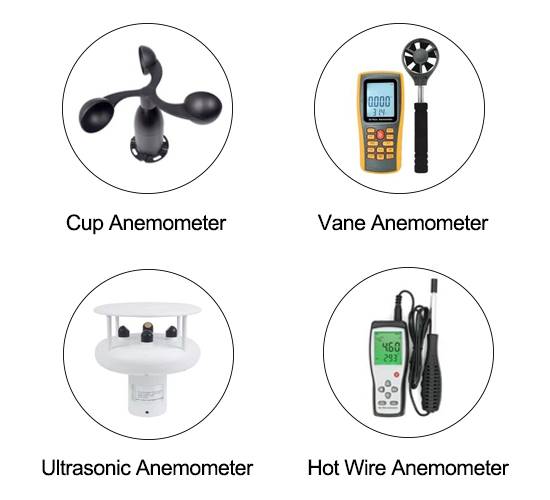Anemometer Buying Guide
An anemometer is a device used to measure the speed of the wind. It is a common instrument in meteorology, environmental monitoring, and various industries whose primary purpose is to provide accurate and real-time measurements of wind velocity. Anemometers come in different types; the following are its main types:
- Cup Anemometer: Consists of three or more cups that rotate in the wind such as 3-cup anemometer. It is the most common type and provides accurate wind speed readings.
- Vane Anemometer: Measures both wind speed and direction by using a rotating vane and now the type of digital vane anemometer is popular among people because of its convience.
- Hot Wire Anemometer: Utilizes a heated wire to measure wind speed and is commonly used in low-speed airflow measurements. And the hot wire anemometers are often used to measure fluid temperature.
- Ultrasonic Anemometer: Ultrasonic anemometer measures wind speed and direction using ultrasonic sound waves in general.
- Sonic Anemometer: Using sound waves to determine wind parameters and offering several advantages over their mechanical counterparts, such as no moving parts, higher accuracy, and a wider range of measurement capabilities.
- Laser Doppler Anemometer: An advanced and highly precise instrument used to measure the velocity of particles, typically in fluids like air or water.

Whether you need a wind speed meter for professional meteorological purposes or for personal use, here is a buying guide to help you choose the right one:
-
Wind Speed Range: Consider the range of wind speeds you expect to measure in your location. Some anemometers are better suited for low speeds, while others can handle high-speed measurements.
-
Accuracy and Calibration: Look for wind gauges with high accuracy levels. Calibration is essential to maintain accuracy over time, so check if the wind speed indicator can be calibrated or if it requires professional calibration.
-
Display and Units: Ensure the wind speed tester has a clear and easy-to-read display. It should provide wind speed in different units (m/s, km/h, mph, knots) to suit your preferences.
-
Durability and Build Quality: If you plan to use the anemometer outdoors or in harsh environments, choose a model with a sturdy build and weather-resistant materials.
-
Power Source: Anemometers can be battery-powered or use renewable energy sources like solar power. Consider your preferences and the availability of batteries in your location.
-
Additional Features: Some gauges to measure wind speed come with extra features like data logging, Bluetooth connectivity for remote monitoring, and integration with smartphones or other devices.
-
Price: Wind measurement devices vary significantly in price based on their features and accuracy. Set a budget and try to find the best balance between features and cost.
-
Reviews and Ratings: Before making a final decision, read customer reviews and check the ratings of the instrument that measure the speed of the wind you are considering. This can provide valuable insights into its performance and reliability.
-
Brand and Warranty: Choose a reputable brand with a good track record in producing quality anemometers. Check the warranty period and terms to ensure you're covered in case of any issues.
-
Purpose: Consider the primary use of wind speed measuring devices. Are you a weather enthusiast, a professional meteorologist, a sailor, or a wind turbine technician? The purpose will influence the specific features you need.
-
Portability: If you need to carry the instrument for measuring the wind velocity around frequently, consider its size, weight, and ease of handling.
Remember to do thorough research and compare different models before making your purchase. Whether you buy online or from a physical store, make sure to check the specifications, reviews, and any additional information that can help you make an informed decision. Or you can shop directly at ATO, because all of our anemometers are of high quality and after-sales service is guaranteed.

